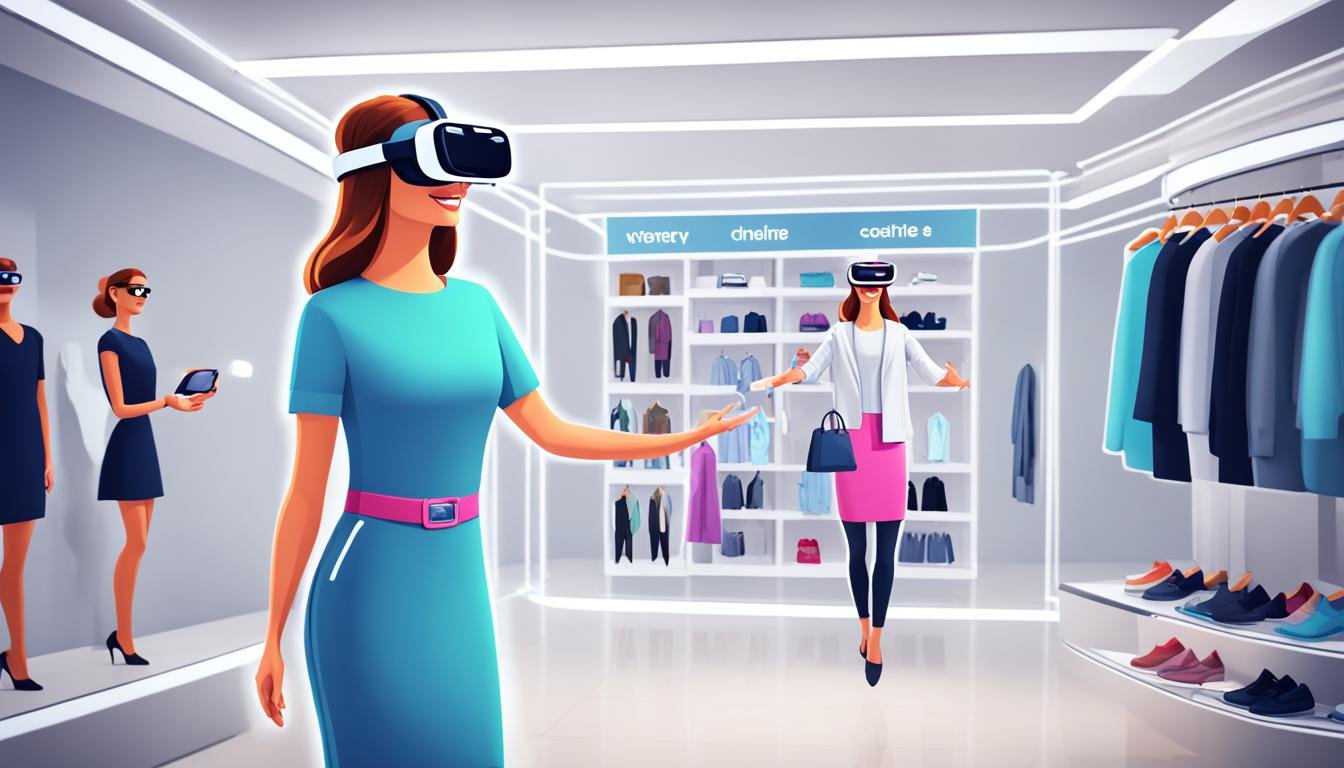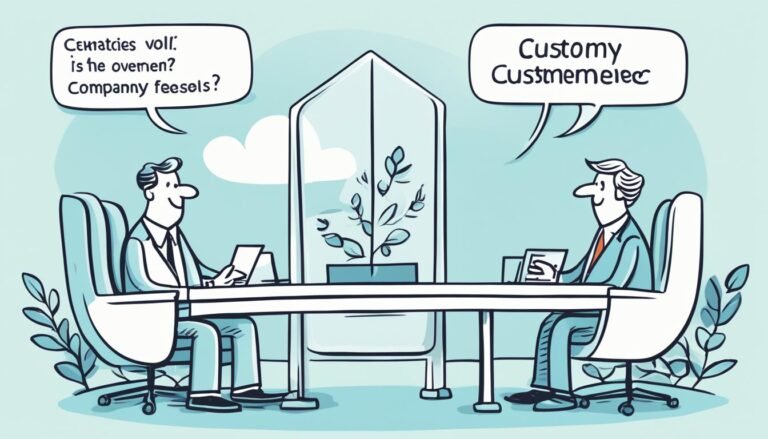Virtual Try-Ons: How AR is Revolutionizing the Online Shopping Experience
Imagine trying on clothes, makeup, or furniture without leaving your house. Augmented Reality (AR) makes this possible. It’s changing how we shop online. AR brings new ways to shop, like virtual fitting rooms and immersive experiences.
Picture browsing clothes on ASOS and seeing how they fit you with just a click. Or, use Sephora’s app to try on makeup without buying it. Nike’s app even lets you scan your feet to see how shoes fit.
Virtual fitting rooms and immersive shopping are changing the game. They help customers, reduce returns, and give brands an edge. AR is set to change online shopping, making it more interactive and personal.
Key Takeaways
- Virtual try-ons use AR to add digital visuals to the real world through a camera.
- Brands like ASOS and Sephora use AR for personalized shopping.
- Nike’s “Nike Fit” feature helps you find the right shoe size with their app.
- Virtual try-ons help with buying decisions and are changing retail.
- AR mirrors boost sales and make customers happier.
Introduction to Augmented Reality (AR) in Retail
AR in retail is changing how we shop by adding digital stuff to the real world. This makes shopping more fun and interactive. Contactless shopping and cool experiences are making stores more exciting.
What is Augmented Reality?
AR adds computer images to what we see in the real world. It makes shopping more engaging and fun. Studies show AR can make people more interested in products than without it.
By 2023, the AR market is expected to hit $11.58 billion. This shows how big and important AR is becoming.
The Evolution of AR in the Retail Industry
AR in retail has grown a lot, from simple product views to cool, interactive displays. Stores like Sephora and Warby Parker use AR for virtual try-ons. This cuts down on returns and makes shopping easier.
IKEA uses AR in stores to let customers see how products fit in their homes. This helps customers make better choices and avoid regrets.
A Google survey found 66% of people want to use AR for shopping help. The AR shopping market is growing fast, at 47.1% a year. It’s expected to keep growing until 2027.
This growth is because more people want new ways to shop. In fact, 92% of Gen Z wants AR tools in online shopping.
Benefits of Augmented Reality in Shopping
Augmented Reality (AR) in shopping changes how we interact with products. It uses virtual fitting rooms and 3D product visualization. This draws in more customers and makes shopping better.
Enhanced Customer Engagement
AR shopping has big benefits for customer engagement. 68% of customers want to spend more time shopping if AR is there. 71% of e-commerce buyers, like Gen Z and millennials, would shop more often with AR.
AR offers interactive experiences. For example, 3D product visualization lets customers see products before buying. This makes shopping 200% more engaging than without AR, helping to boost interest and sales.
Reduced Product Return Rates
AR shopping tech, like virtual fitting rooms and 3D product visualization, lowers return rates. In 2020, around $102 billion worth of items were returned, often because they didn’t match what customers expected. AR can cut returns by up to 40%, giving customers a clear view of what they’re buying.
Stores using AR see sales go up by up to 135%. Apps like IKEA’s “IKEA Place” show how AR helps customers see furniture in their homes. This leads to better shopping experiences.
As AR gets better, it will bring more benefits to shopping. It will make shopping more engaging, accurate, and satisfying for people all over the world.
Virtual Try-Ons and Their Impact on Customer Experience
Virtual try-ons have changed how we shop, making it feel like we’re trying on products in real life. They close the gap between online and in-store shopping. Now, customers can see how things like watches will look on them, thanks to these technologies.
The Rise of Virtual Try-Ons
The watch industry is now using augmented reality to make shopping better. Virtual try-ons let customers try on watches without leaving home. Sites like Watchbox, MirrAR, and AR Watches make this easy, without needing to download anything.
Improved Decision Making for Shoppers
Virtual try-ons make it easier for customers to decide what to buy. They offer a real shopping experience online, helping customers choose better. This leads to happier customers and fewer returns.
Now, virtual try-ons are changing how we buy watches online. They let us see how a watch will look and fit before we buy it. Studies show that using augmented reality can boost sales and cut down on returns, making online shopping more engaging.
Virtual Fitting Rooms: A Game Changer for Fashion Retail
Virtual fitting rooms have changed the game in fashion retail. They combine technology with shopping for a new kind of experience. Now, shoppers can try on clothes without leaving home, thanks to augmented reality.
How Virtual Fitting Rooms Work
Virtual fitting rooms use AR to put clothes on your body. They do this with advanced algorithms and 3D body scans. This gives you a clear idea of how clothes will look and fit.
Retailers like Amazon have brought in “magic mirrors” for customers. These let shoppers see their whole wardrobe without trying it on. This makes shopping more immersive.
Tools like Fit Analytics and Body Labs create detailed 2D and 3D models of customers. These have cut return rates by a lot. Fit Analytics says virtual fitting can cut returns by up to 50%. Body Labs reports a 36% drop, showing happier customers and lower costs for stores.
Case Studies of Successful Implementation
Many fashion stores have started using virtual fitting rooms. Watchbox uses an AR app for customers to try on watches virtually. Biba teamed up with Astrafit for virtual try-ons, making sure the fit is just right.
A survey by Retail Perceptions found 61% of shoppers like AR and VR in stores. This shows how virtual fitting rooms can make shopping better, leading to more sales.
The tech behind virtual fitting rooms is still growing. It takes a lot of work and money to improve. But the benefits are big. Retailers see better customer advice and more sales from this new tech. Amazon Style stores show how virtual fitting rooms can mix online ease with in-store fun, becoming key for the future of shopping.
3D Product Visualization: Bringing Products to Life
Online shopping is big, and 3D product visualization is changing the game for stores. This tech makes shopping better and cuts down on returns. It also makes customers happier.
Virtual Furniture Placement
3D product visualization is amazing for augmented reality home decor. People can see how furniture will look in their homes before buying it. This helps them feel sure about their choices without leaving home.
Statistics show that virtual try-on boosts sales by building trust. These tools let customers see and change their choices instantly. This makes shopping more personal and fun.
3D Visualizations for Accessories
3D product visualization isn’t just for furniture. It also works for AR accessories like jewelry. Customers can see how things like earrings and necklaces will look on them before buying. This makes shopping more satisfying and cuts down on returns.
Stores like Sephora and Warby Parker use AR to let customers try on virtual accessories. These tools keep customers coming back and boost sales. They show how using new tech can really pay off.
3D product visualization makes shopping more fun and personal. It’s changing online shopping for the better. It helps customers make better choices and supports sustainable shopping.
Immersive eCommerce: The Future of Online Shopping
Immersive eCommerce is changing the way we shop online. It combines the virtual and physical worlds for a more engaging experience. With AR technology, shoppers can see products in real life and get personalized shopping trips.
What is Immersive eCommerce?
Immersive eCommerce uses AR to make online shopping fun and interactive. Shoppers can try on products virtually and see them in their own space. They also get recommendations based on what they like. This makes shopping more satisfying and helps with making choices.
Trends and Predictions
The future of shopping online is all about immersive eCommerce. Trends show more people want to try on products virtually and see them in real life. Brands like Google and Shopify have seen big increases in sales thanks to AR.
AR is set to change retail by making shopping more engaging and reducing returns. But, there are challenges like cost and privacy to consider. Working with tech partners and using platform-as-a-service can help overcome these issues. As AR technology grows, online shopping will get even better, offering unique and personalized experiences.
AR in Retail: Real-World Applications
Augmented Reality (AR) is changing how we shop by making it more fun and interactive. Brands like IKEA and Sephora use AR to let customers see products in real-time. This makes shopping more exciting.
Examples of Brands Using AR
Many big brands are using AR to improve shopping for customers:
- IKEA: Has an AR app called IKEA Place. It lets customers see furniture in their own homes.
- Sephora: Uses AR for virtual makeup try-ons with its Virtual Artist feature.
- Wayfair: Uses AR to let customers see furniture in their spaces, which boosts engagement.
- GAP: Offers virtual try-ons for denim, which has led to a 30% increase in online sales.
- L’Oreal: Works with Snapchat for virtual try-ons, which has increased engagement by 150%.
Consumer Adoption Statistics
More and more people are using AR in shopping, thanks to its fun and interactive nature. Here are some key stats:
- By 2024, there will be 1.73 billion mobile AR users.
- Ecommerce sites using AR see a 20% boost in customer engagement and satisfaction.
- By 2025, almost all social app users and 75% of the global population will use AR often.
- AR can boost conversion rates by up to 90%.
- EQ3, a furniture retailer, saw a 112% increase in conversion rates with their AR app.
- A Shopify study found 63% of consumers are more likely to buy from brands with AR experiences.
Interactive Product Displays: Engaging Customers Digitally
The retail world is changing fast with interactive product displays. These use Augmented Reality (AR) to change how customers see and interact with products. AR brings many benefits of AR in retail, like better customer engagement and a deeper shopping experience.
How Interactive Displays Work
Interactive displays mix AR with real products, seen through smartphones or AR glasses. This mix lets users see digital info in real-time. When customers look at a product, AR shows them more about it, like how to use it and other details. This keeps customers interested and boosts digital customer engagement.
Benefits for Retailers and Consumers
For stores, AR in product displays has many perks. It helps cut costs on storing lots of items. These displays make showing off products fun and engaging, leading to better sales and loyal customers.
Customers get a lot from these displays too. AR lets them see products from every angle before buying. This makes them feel sure about their choices. Plus, the digital customer engagement makes shopping more enjoyable and personal.
Interactive displays show how AR can link online and offline shopping. They make shopping a fun and connected experience for customers. As AR gets better, it will likely help sell more and make customers more loyal to brands.
Virtual Make-Up Try-Ons: Transforming Beauty Products Shopping
The beauty industry is changing fast, thanks to virtual make-up try-ons. This new way uses AR in beauty industry tech to let shoppers try products online. It makes shopping fun and interactive.
AR Applications in Beauty Industry
Brands like Sephora, L’Oreal Paris, and Charlotte Tilbury use AR to let people try makeup online. Sephora’s Virtual Artist lets customers try thousands of products and follow tutorials. This makes shopping better.
Using AR has made customers more engaged and likely to buy. In fact, 59% of shoppers want to buy more after seeing products in AR. Sharing these try-ons online also brings in new customers.
Customer Feedback and Insights
Customers love virtual make-up try-ons. On Snapchat, 93% of users want to shop with AR. This feedback helps brands make better products and ads.
This tech also lets customers try makeup safely at home. Only one-third of makeup users like in-store testers. Brands using virtual try-ons see a 64% drop in returns. This is good for the planet and saves money.
Conclusion
The online retail world has changed a lot thanks to AR technology. Now, shopping online is more like being in a store. AR lets people try on clothes and see products in 3D, making shopping fun and interactive.
The AR market is growing fast, expected to hit $198 billion by 2025. This matches the global fashion e-commerce market’s value of $821.19 billion. AR technology is making shopping better by helping stores sell more and reducing returns.
More people want to shop online with AR, making it key for stores to stay ahead. Brands like Walmart and Adidas have seen more sales and happy customers with AR Try-On. The future looks bright with more realistic virtual try-ons and social media links.
AR Try-On is changing how we shop online. It makes shopping personal and fun, shaping the future of e-commerce. This technology is set to keep making online shopping exciting and unique.
Source Links
- Virtual Try-Ons: Revolutionizing the way we shop
- The Formats & Flavors of AR Virtual Try-Ons – AR Insider
- QReal | How AR Mirrors are Transforming Our Shopping Experience
- Augmented Reality in E-commerce: Revolutionizing Online Shopping and CRO – SiteTuners
- Augmented Reality (AR) in Retail: How AR is revolutionizing the shopping experience and customer engagement. – GeeksforGeeks
- AR in Retail: Cool Use Cases & Key Benefits | Zakeke
- How AR Is Revolutionizing Shopping Experiences
- Future of Watch Shopping with Virtual Try-Ons
- How Augmented Reality is Changing the Shopping Experience
- Virtual Try-Ons Technology | PulpoAR
- QReal | Revolutionizing Fashion Retail: The Rise of Virtual Fitting Ro
- How virtual fitting rooms are changing the way we shop for clothes?
- Revolutionizing Customer Engagement with 3D Product Visualization
- 3D Product Visualization: Revolutionizing E-Commerce
- Augmented reality ads: Virtual Try Ons: Revolutionizing Online Shopping with Augmented Reality Virtual Try Ons – FasterCapital
- Revolutionizing Ecommerce: The Future of Shopping with VR and AR
- Try Before You Buy: Revolutionizing Ecommerce With Augmented Reality – Vizion Interactive
- Augmented Reality in Retail: Use Cases & Business Benefits
- AR in Retail: Revolutionizing Shopping Experiences
- AR in Retail: Transforming the Shopping Experience for Growth
- How Augmented Reality is Shaping the Future of E-Commerce Marketing
- The Future of Marketing With Augmented Reality (AR) and Virtual Reality (VR): Immersive Experiences and Brand Engagement
- Revolutionizing Shopping: Maximizing Sale With AR in eCommerce
- Transform Online Shopping with Virtual Try-On Technology
- The Power of Virtual Try- On in the Beauty Industry – Designhubz
- How AI And AR Are Enhancing The Beauty Space
- Virtual Try-On Technology for the Luxury Industry: How It Works, Benefits & Challenges
- Revolutionizing Online Shopping with AR Try-On: A Comprehensive Guide







